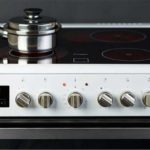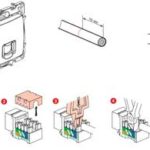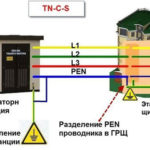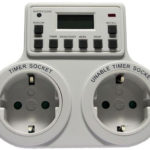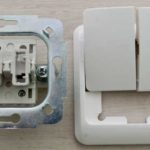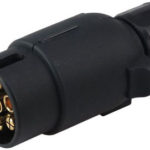When laying electrical wiring in houses or apartments, fittings are selected, which include sockets. They must meet the requirements of reliability, quality and aesthetics. The market offers a wide range of these products, both domestic and imported, which makes it difficult to choose, especially for inexperienced buyers. Electricity must not come into contact with the parts and housing of these devices. Therefore, each outlet must be grounded.
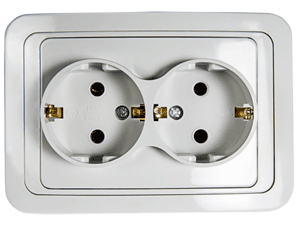
Content
Why do you need grounding in the outlet?
All sockets with grounding have 3 pins, which are designed for phase, neutral and ground wires. The latter goes to the electrical panel, in which it is connected to the terminal of the same name.
Such products are used for rooms with laid wiring, consisting of three cores.If it is equipped with a two-wire, then the socket will not perform protection against electric shock. So the wiring needs to be replaced.
It is most dangerous to operate devices with a metal case and those that come into contact with water without grounding.
Features of installing a socket with grounding
The socket with grounding is connected simply. Any person who is familiar with the theory and shows attention in the implementation of the installation will cope with this task.
Before installation, you need to determine the type of wiring. To do this, the old ordinary socket is disassembled, after which the number of wires connected becomes visible. If their number is two, then only phase and neutral are available, and there is no ground.
When buying, pay attention to the socket housing with grounding. It must not be damaged. For residential premises, these devices are selected taking into account aesthetic properties. To the greatest extent, they correspond to "internal" sockets, which are built into a small niche in the wall.
Rating information is on the back of the device. For a home electrical outlet, the value should be 30-100 mA. Domestic are designed for 6.3 and 10 A, and foreign - for 10 or 16 A.
Preferences in the assortment are given to those that are intended for most of the electrical appliances used in everyday life. The euro socket with grounding has a greater distance between the holes and their larger diameter. From a properly selected device, the plug is removed with minimal effort.
The product on the market is presented in the following assortment:
- for powerful equipment - withstand current from 20 A and above, are sold with a special plug;
- equipped with lightning protection - used in regions with increased lightning activity;
- having special shutters that protect a person from accidentally touching the contacts;
- equipped with current leakage protection - they are used mainly in children's rooms;
- with surge protection - used for expensive equipment;
- equipped with overload protection with a built-in fuse that burns first in case of a short circuit.
Before deciding how to install the outlet, you need to choose a socket. The purchase of the latter is made depending on what material the wall is made of. You need to mount its box in a special recess located inside the base.
When buying, pay attention to the contacts of the product. They must be metal. The body of sockets is made of ceramics.
A positive point for the socket is the presence of a screw clamp. Inside there are two plates, between which wires are passed. Fixing with screws contributes to a good fastening of the contacts and does not allow them to loosen during operation.

It will be possible to determine how to properly connect the outlet with the help of a tester. The power supply is turned off on the shield, the wiring is carried out in different directions.
Grounding sockets in an apartment is due to the fact that in a residential area it is unaesthetic to use round timber or a metal bus as grounding conductors, which are used in this capacity at production sites.
In those houses that were built after 2003, it is planned to lay a five-core riser.In it, one of the wires acts as a conductor, providing an electrical connection to the ground.
When using TN-C-S or TN-S systems indoors, the question of how to ground the outlet is easily solved. The devices contain N- (zero) and PE- (protective) conductors and from one to three phases L, connected in the main switchboards. Here are the tires to which the conductors of the earth, zero and phase are connected, coming from the apartment. The ground bus is connected to the electrical panel housing made of metal.
Grounding outlets in the apartment is as follows:
- the power supply is turned off;
- zero and phase are connected to the terminals located near the holes (they are pre-determined by a tester or indicator);
- the ground cable is connected to the terminals located in the center of the outlet.
When installing double, triple products in one socket, the jumper terminals between the devices are connected. Wires with terminals do not pinch too much, as this contributes to their fracture. After carrying out these steps, the socket with grounding is put in its place in the wall and fixed with stoppers.
There is another system common in old houses called TN-C. It is necessary to consider how to ground the outlet in it.
This system consists of two- or four-core cables. When connecting an outlet, instead of grounding, some use zeroing. In this case, protection is mainly reduced to the prevention of short circuits through automatic shutdown. But it is not able to protect a person from electric shock.
In this case, there are two options:
- Contact the power supply companies that carry out the grounding of the neutral wire, changing all the wiring. Grounding is then connected to all outlets.
- RCD automata are built into the electrical circuit that feeds the most powerful household appliances. In the event of a breakdown, they will not protect against electric shock, but they will save you from death.
Wrong connection - what to look for?
When connecting sockets with grounding, the main mistake is to install them on wiring that has two cores. The neutral wire is like ground. Danger to life is the installation of a jumper from the neutral to the ground terminal.
This cannot be done for the following reasons:
- if the insulation of the neutral core is damaged, a phase short circuit will occur on the equipment case, which will lead to the inoperability of the devices, while the socket will seem safe;
- in this system, each core has the same color, due to which the phase and neutral can be mixed up in places, which will lead to phase voltage getting on the socket housings.
When connecting sockets with grounding, heating and water pipes cannot be used as the latter. This is due to the fact that if the neighbors decide to replace metal communications with plastic ones, then a gap will occur, due to which stray currents are formed that contribute to the appearance of electrical injuries.
How to check the grounding in the outlet?
To do this, you need a multimeter and a tester screwdriver. In the presence of multi-colored wires, black-brown insulation is present on the phase. The test is first carried out with a tester, introducing it one by one into the holes of the outlet. The indicator will turn on when the phase is touched.
Subsequently, the presence of grounding is checked with a multimeter.The center or upper part of the outlet (its grounding) is touched with one probe, introducing the second one alternately into its holes.
The absence of voltage between the conductors indicates the following:
- neutral-grounding - about the jumper between them;
- phase-grounding - about the absence of the latter;
- phase-neutral - about breaking the latter.
With a properly working ground, during the measurement of the voltage between it and the neutral, the readings of the device should be different from 0, and the maximum result should not exceed 90 V.
What to do if there is no ground loop in a multi-storey building?
Two ways out of this situation have already been demonstrated (replacing all the wiring in the house and installing RCDs). But the last of them provides only instantaneous protection, while working in conjunction with the ground electrode.
Therefore, the right choice is to replace two-core cables with three-core ones. It is necessary to equip the ground loop on the back of the house. The wiring of the grounding conductor to individual apartments is carried out using a copper bus, which has an equal or larger cross section compared to the PEN conductor, which is included in the cable connected to the house.
Before grounding the outlet, you need to build a protective circuit. Not far from the blind area (at least 1.5 m), triangular trenches are made with sides of 1.2 m to a depth of 0.6 m. An additional trench is dug to the blind area, along which grounding will be connected to the switch cabinet in the entrance.
At the corners of the triangle, metal pipes or corners of small diameter with a length of 2.5 m or more are clogged.
Their tops are connected by welding a metal connection (steel strips 40x4 mm of the required length).
After the ground line from this structure leads to the entrance switch cabinet:
- from the nearest vertex of the triangle, along an additional trench, a steel strip of the same section is laid as that of the metal connection;
- its end is fixed with a dowel-nail to the house wall;
- the installed structure is covered with earth and rammed.
After pulling the ground line to the switch cabinet in the entrance, each owner will be able to forward their ground buses to it, connecting them to the main one. By performing these time-consuming, but not difficult steps, a solution is found on how to make grounding in an old house.
Similar articles:
